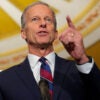Have you heard your member of Congress say much about what he or she would do to control the national debt lately? If you’re like most Americans, you probably haven’t heard the debt mentioned very much for quite a while now.
That’s because Congress suspended the debt limit in February 2014 and the day of reckoning has yet to come.
So it goes with the debt as with so many other unpleasant facts of life: Out of sight, out of mind.
Not this week. The Congressional Budget Office released its 2015 Long-Term Budget Outlook, projecting U.S. spending, taxes, deficits and the debt for the next 25 years. The CBO report stressed that the “long-term outlook for the federal budget has worsened dramatically over the past several years.”
Following the Great Recession, the national debt borrowed in credit markets, also called the publicly held or public debt, doubled to about 74 percent of the economy’s annual output (as measured by GDP) in 2015—a level not seen since World War II. The public debt constitutes about $13 trillion of the $18 trillion national debt.
CBO projects that higher spending, especially for interest on the debt, Social Security, and the government’s major health care programs (Medicare, Medicaid, Obamacare and the Children’s Health Insurance Program) would drive the public debt to exceed 100 percent of the economy’s annual output by 2030.
While most reporting suggests that public debt would not reach this level until 2040, this estimate is based on rosier assumptions than are realistic. If recent history is any indicator, CBO’s alternative fiscal scenario is a better predictor of what’s likely to come.
According to the sobering report:
Federal spending for Social Security and the government’s major health care programs … would rise sharply, to 14.2 percent of GDP by 2040, if current law remained generally unchanged. That percentage would be more than twice the 6.5 percent average seen over the past 50 years. The boost in spending is projected to occur because of the aging of the population; growth in per capita spending on health care; and, to a lesser extent, an increased number of recipients of exchange subsidies and Medicaid benefits attributable to the Affordable Care Act.
Greater spending on entitlement benefits as more and more Americans reach the age at which they become eligible for Social Security and Medicare poses by far the greatest challenge. Just over the next 10 years, the number of people age 65 or older is expected to rise by more than one-third.
Meanwhile the ratio of workers paying for generous and outdated entitlement programs to beneficiaries on the receiving end will decline significantly over the next generation—from 3 to 1 now to almost 2 to 1 in 2040.
According to CBO’s estimates, between now and 2025, 62 percent of the growth in Social Security and health care spending is explained by aging; 21 percent is explained by Obamacare; and 17 percent by rising health care costs. Notably, rising health care costs continue to be a problem even assuming Obamacare remains current policy.
These numbers convey in no uncertain terms that America’s entitlement spending problem will not be fixed with tweaks that lower health care costs. Structural entitlement reforms that better target benefits to those individuals who need them the most and at a level that protects seniors from poverty without unduly burdening the younger generations with much higher taxes or a crushing debt burden are necessary to improve the nation’s fiscal outlook.
The sooner Congress confronts this reality, the better for the nation, because adopting common-sense entitlement reforms now will allow lawmakers to phase changes in predictably and gradually. Waiting too long could mean sudden and steep benefit reductions that will hurt the most vulnerable Americans the most.
It’s overdue that Congress control spending and the debt.
































